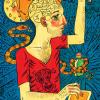For everyone else following the thread up to this point, here is a summary so far:
- Concluded of effective Forksolin Doses are: 4mg (no side effects) or 10-20mg (with side effects of tiredness on the long term especially on the 20mg end)
- For PDE 4 Inhibition anywhere 400 to 1200mg of Artichoke Extract, or 500mg to 1g of Quercertin (Quercertin has a much longer half life than Artichoke extract)
- A source of dopamine precursor L-Phenylalanine or Tyrosine at 500 to 1000mg. This could be replaced by a stronger stimulant like caffeine or low dose amphetamine. Some other additions suggested or NOS or NAC.
Overall effect: improved long term learning, but no noticeable affect on working memory, intelligence or creativity. Some report increase motivation and focus (but could be due to stimulation refer to below)
Possible Contraindictions - Does not work with Aniracetam. Vasodilation chemicals.
Possible Problems : possible hepatoxicity at higher doses, desensitisation of acetylcholine receptors
I usually don't contribute to threads, since my working memory (or memory in general) or even intelligence is poor. So i'm not good at finding scientific backup for stuff...
I don't really understand the rationale behind taking stuff daily without breaks. In my experience/knowledge the brain/body is exceptionally good at returning processes to status quo via homeostasis. Meaning taking most things daily would probably ensure the body fighting back in some way (e.g. getting tired, because the body is probably trying to get sleep from all the potentiating). Cycling or taking breaks makes most sense for most regimens, unless some mechanism of tolerance can be alleviated.
Also some of the stuff that have longer half lifes linger in the body when taken daily and thus "stack up".
A lot of the effects on the thread regarding quercertin might not be due to PDE4 inhibition, but due to it being a COMT inhibitor. This would explain why less stimulants are needed (because they are being potentiated), thus increasing baseline dopamine levels could therotically temporarily improve focus, motivation and reduce anxiety.
Another point is : Caffeine is often underestimated as a stimulant because its so common, but at 100mg its actually pretty damn potent and could contribute significantly to a placebo effect (energy, motivation, better memory, performance). I mean looking at how most pre-workouts don't even work without caffeine says to me how damn effective caffeine actually is.
On a peronal note, I found the stack to not work with piracetam, it seems like whatever it does it counters piracetam's affinity for working memory and creativity improvements. I'm not 100% certain yet, but this stack seems to improve learning at the cost of short term awareness and problem solving, which kind of make sense as these might be two ends of the spectrum. People with bad memory have been found to be able to be more "present" and able to deduce/problem solve things in the moment (some article in the internet), this is due to the fact that their brains are not clogged up by all the recall associated with good long term memory.
Its plausible of course that short term awarness (piracetam effects) and long term learning (CILTEP) effects are two completely different systems, and it justs happens that Piracetam doesn't work with Ciltep,
or rather Piracetam doesn't offset CILTEP enough to feel/see the benefits that I would normally associate with Piracetam alone. Either way it didn't feel as synergistic as I would have hoped it to be.
I'm also mildly confused about the MET/VAL gene thing. So lets get this straight or wrong: but VAL/VAL (Warrior) gene leads to high levels of COMT which means more enzymes to break down dopamine e.g. easier to have lower level of dopamines? and Worrier Met/MET leads to low levels of COMT which means dopamine stays elevated easier. So Val/Val is more likely to have poor working memory and ADHD, but this doesn't make sense to me as ADHD and Social anxiety are comorbid as well as a host of other problems, and how does that make sense. If any of the above is right (provided I haven't got the order confused), then warrior mentality and "being inattentive and so on" are the same side of the coin.
So I react strongly to stimulants, but I find my levels dip very very easily. If I take an amphetamine i'm out for a week, ritalin i'm out for the entire evening. It seems my dopamine runs out very quickly, even caffeine seems to run out on me quicker than most people, and it takes longer for my dopamine to go back to baseline. Am I warrior or worrier? I understand most people actually fall on Met/Val which mean they respond "normally", as I don't consider my responses normal I think i'm either Val/Val or Met/Met.
Regardless I have a interesting in quercertin also for its other effects, and the CILTEP stack i'm looking forward to being able to help me on my difficulties on learning one subject. Whilst I find it easy to learn multiple subjects and cross-pollinate them. I find it hard to be one of those "doctor" types and just gobble up information on one subject.
Edited by Major Legend, 29 July 2012 - 08:23 PM.

















































